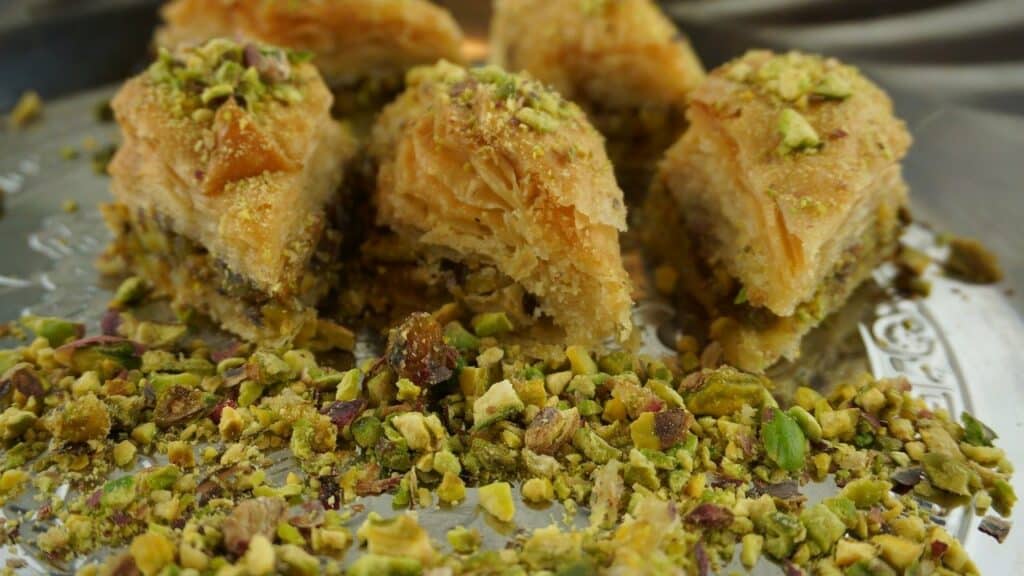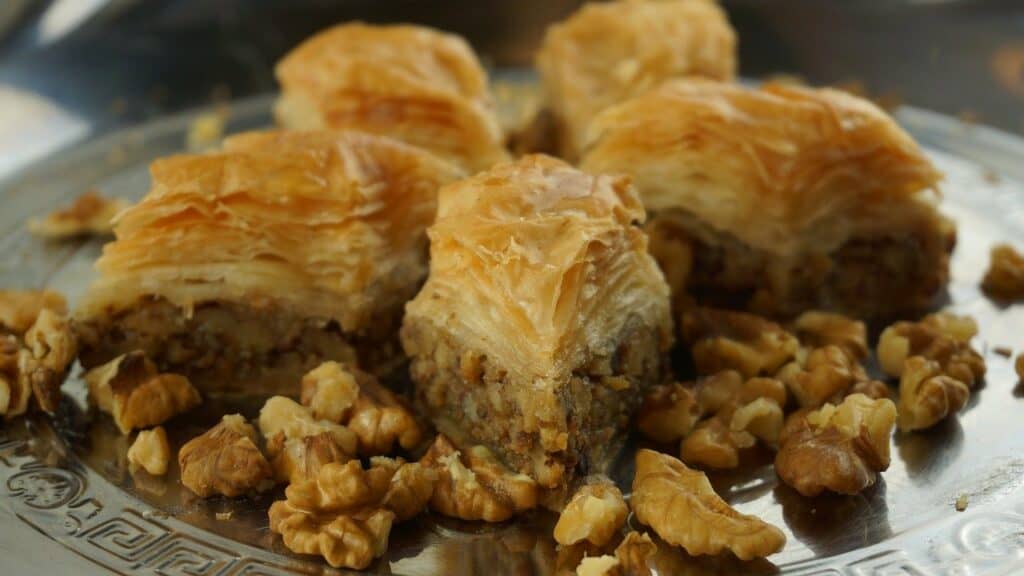
What is baklava?
Baklava is a baked Mediterranean pastry dessert. It is made with buttered flakey layers of thin phyllo dough and finely chopped spiced nuts, drizzled with sweet syrup and lemon. The most common nuts used are walnuts and pistachios, but hazelnuts, almonds, and cashews are sometimes incorporated into baklava. The nut mixture and sweeteners vary depending on which region the baklava comes from.
Variations of baklava include using different nuts, using different numbers of sheets of phyllo dough, and adding different flavors to the syrup (which can be made of honey or sugar) or filling (including cinnamon, cloves, cardamom, and rosewater).
Some baklava recipes pour hot olive oil over the pastry instead of brushing the phyllo sheets with butter. Adventurous bakers sometimes add non-traditional ingredients like chocolate chips or dates. Baklava can be cut into different shapes to serve, but it is always served in small portions, as it is very rich.
Where is baklava from?
Baklava is a staple dessert in many Mediterranean cuisines, and it can be traced back as far as 800 B.C. The word “baklava” comes from a Mongolian root meaning “to wrap up or pile up,” referencing the baklava preparation technique that involves stacking layers of dough and filling.
Baklava may have originated in Turkey and later been modified in Greece. The Turkish city of Gaziantep is famous for its baklava, and Turkish people regard it as baklava’s birthplace. It’s believed that the Greeks modified the original baklava recipe to use light phyllo dough, which is now used in all baklava recipes—the word “phyllo” means “leaf” in Greek. However, the origins of baklava are disputed. Many ethnic groups claim that baklava originated in their culture.
Different regions developed their own versions of baklava over time. The simplicity and versatility of the recipe, combined with its long shelf life, have made baklava one of the most popular desserts in Greece, Turkey, and the Middle East.
Baklava is served at many special occasions including Rosh Hoshannah, Christmas, Eid Al-Fitr, Easter, and other celebrations & weddings.

How to Store Baklava
Baklava can last over two weeks stored in an airtight container, either at room temperature or refrigerated. For crispier baklava, store it at room temperature. For a chewier and harder baklava, store in the fridge.
Baklava can also be stored in the freezer for up to four months. To freeze baklava, wrap it tightly in at least four layers of plastic wrap and place it in a freezer bag. Place the frozen baklava in the fridge for 4-6 hours or overnight to thaw.
Three Flavors of Baklava
1. Pistachio Baklava
Pistachio baklava, also known as “fstikli” baklava or traditional Turkish baklava, is the most common flavor of the dessert. It is made of phyllo dough, finely crushed pistachios, butter, and a simple syrup of sugar, water, and lemon juice.
2. Walnut Baklava
Walnut baklava, or Greek baklava, opts for finely ground walnuts instead of pistachios layered between the phyllo dough sheets and is sweetened with honey instead of sugar. Many other flavors of baklava also have some crushed walnuts blended in with other nuts.
3. Lebanese Baklava (Baklawa)
This type of baklava is popular in Lebanon. In Arabic, it is called baklawa (pronounced bak-la-wah). This recipe calls for a rosewater and orange blossom sweet syrup called “atter.” Baklawa is also made with sheets of phyllo dough and typically contains the same nut mixture as Greek baklava: ground walnuts spiced with cinnamon.
These are just a few examples of baklava flavors. There are many different variations of this rich dessert from around the world!

